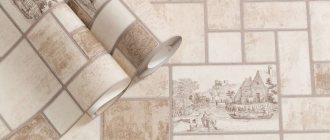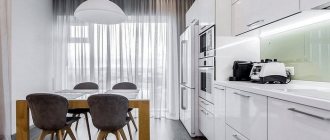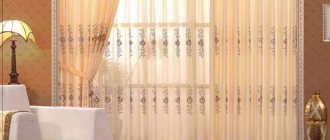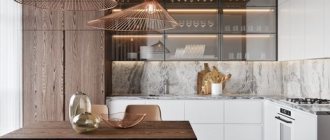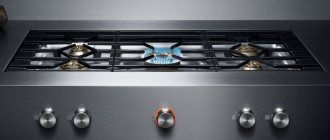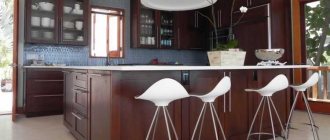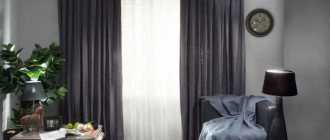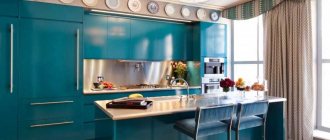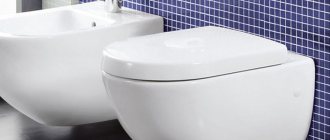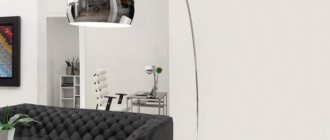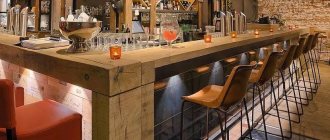What does a modern kitchen consist of?
Frame
The furniture frame to which the facades and tabletop are attached. Cabinets are almost always made from chipboard. This is a fairly wear-resistant and durable material at an affordable price.
Facades
Doors set. A decorative part of furniture that determines its primary color. Materials: wood, chipboard, MDF. The latter are coated with plastic, Alvic Luxe, film, enamel.
Tabletop
The working surface of the tables into which the sink and hob cut into. Made from plastic, artificial or natural stone. Much less often - made of wood, tiles, stainless steel.
Apron
A decorative element of a set that covers the wall between the work surface and wall cabinets (shelves). It can be made of ceramic tiles, glass, countertop material (plastic, stone).
Accessories
Handles, legs, hinges, latches, fastening / lifting mechanisms for furniture from different manufacturers are presented in a wide range, it is very important to make the right choice. The functionality and service life of the entire furniture set depends on the quality of the fittings.
Appliances
It is divided into built-in and conventional, free-standing (the first option fits harmoniously into any design, the latter is more economical). The list of the most common household appliances for the kitchen includes a stove (hob), oven, microwave, refrigerator, extractor hood, and washing machine.
Washing
A must-have component in any kitchen. Can be overhead or integrated into the countertop. Made from stainless steel, plastic, artificial stone.
Our experts will tell you how to choose the right kitchen and what to pay special attention to when selecting the above elements. This article will give answers to many questions regarding the arrangement of a kitchen space and will reveal the main aspects of choosing the right furniture.
In order to choose the right kitchen, without later regretting the decision, it is important to pay attention to the following aspects: manufacturer, material used to make each element, color, style, layout, equipment, cost of the kitchen.
How to choose a kitchen color
One of the most important aspects of kitchen interior design is the choice of color of kitchen furniture. It should be done based not only on personal preferences, but also on the style of the interior, lighting, size of the room, and the color scheme of its decoration. If you are at a loss as to what color to choose for your kitchen, pay attention to the most popular color shades of kitchen sets:
Black
A fairly common choice for creating many modern interiors in classic, high-tech, minimalism, and modern styles. Combines well with white and red colors, metal, glass. Requires a competent lighting device with indispensable illumination of the work area.
White
The white color of kitchen surfaces will expand the space of a small kitchen and make it lighter. But at the same time it will look boring, even sterile, if it is not diversified with bright accessories, color accents, and contrasting elements.
Brown (wood color)
The most common color when decorating this room. Kitchen facades made of wood or wood look make it feel homely and conducive to relaxed communication. A universal, almost win-win option.
Red
A spectacular, exciting, very aggressive color, which is often chosen by people who do not bother with daily cooking and do not spend a lot of time in this room. Keep in mind that the rich red color will stimulate your appetite!
Blue
Depending on the chosen shade, a blue kitchen can be made calm and cozy or fashionable and dynamic. Too dark a blue is not recommended for use in rooms suffering from a lack of sunlight.
Green
A calm, relaxing color of furniture after a busy day will restore your peace of mind and set you in the mood for cooking and a pleasant evening at home. Light green facades will help expand the space.
When choosing the color of the facades, keep in mind: too bright, contrasting or dark colors can negatively affect the psychological state of household members, quickly tire the eyes and visually reduce the area of the room. Therefore, if you have a small / poorly lit kitchen, or you spend a lot of time in it, light pastel shades will be more appropriate, visually expanding the space and guaranteeing psychological comfort to people - peach, beige, cream, pink, blue, pistachio. You can diversify this color scheme with bright accessories and decorative elements.
1. Be sure to consider the level of natural light in the room. If its windows face the shady side, choose light or bright cheerful colors. Otherwise, the lack of light will be felt even when the lights are on.
2. Remember that light-colored surfaces of cabinets and facades (especially white) will not only visually expand the space, but will also require particularly thorough cleaning, carried out with high frequency. And on dark glossy surfaces fingerprints are clearly visible.
Features of choosing a kitchen set
Everything is important in the kitchen: both finishing and filling. This room is used daily, “extreme” conditions are created here (high temperature and humidity), during cooking, a large amount of waste (water, grease, dirt) settles on the surfaces of furniture and decoration, which is why the room is cleaned regularly (much more often than others premises).
Furniture must withstand such loads, withstand sudden changes in the “climate”, be easy to clean and serve people faithfully for a long time. For kitchens, they often use not individual items, but sets - furniture complexes.
They first appeared in the USA back in the last century and housewives liked them so much that their mass production was quickly launched. Europeans adopted this experience from the Americans, “tasting” the idea. In Soviet times, sets were colloquially called “walls” and were actively used not only in kitchens, but also in living rooms. Furniture selected by the manufacturer eliminates the need for the buyer to “assemble” a set of different items on their own.
Perhaps this is the main advantage of headsets. In addition, the price of the set is lower than the total cost of all the items included in it if purchased separately. A furniture set usually consists not only of a “wall”, but is also complemented by a dining table, chairs and movable elements.
When choosing a kitchen set, you should pay attention to four characteristics:
- Aesthetics (appearance).
- Functionality.
- Long service life.
- Ease of use (ergonomics).
Let's talk about each of them in more detail.
Aesthetics
The aesthetics of a headset is its beauty from the point of view of the person choosing (this is important, because everyone has their own ideas about beauty). What can you say about the appearance of kitchen furniture? Of course, it should look appropriate in combination with other pieces of furniture and at the same time please the hostess and household members.
You can’t just choose a model you like, for example, in Provence style, and put it in a kitchen that is already decorated in a high-tech style. The filling and finishing must match each other.
Functionality
You can determine what opportunities a set provides to the housewife by getting acquainted with its contents, that is, its components. What should be included in a kitchen furniture set for it to be considered complete and fully satisfy the requirements of the person using it? The standard list of modules and add-ons is as follows:
- Floor structures. These include cabinets, cabinets and shelving systems (mostly closed types).
- Pencil cases. Tall narrow cabinets that are designed to accommodate built-in household appliances and kitchen utensils.
- Wall-mounted lockers. Can be closed or open. Usually they present a mixed storage system of shelves and drawers.
- Mobile elements. Screens, partitions, tables on wheels, transformable furniture. Such elements are usually complemented by sets designed for cramped kitchenettes.
- Free-standing furniture: tables, chairs, corner sofas.
The contents of the set are selected depending on the characteristics of the kitchen and the needs of the housewife, that is, individually for each home. Some people need more drawers, while others would prefer to give up half of the storage system for new household appliances.
Ease of use
Any furniture should be comfortable to use. Even before buying, you need to “try it on”, that is, try out what it’s like at work, whether the height suits the owner, whether the shelves are conveniently located, whether it can reach all the drawers. Next, you should carefully take measurements and think in advance about the location of the headset in the room. You need to take into account the ease of movement between the vertices of the work triangle and the possibility of creating additional “routes” from the dining area to the work area, stove and refrigerator.
Durability
The durability of a headset is primarily determined by the materials from which it is made. Solid wood is considered optimal for the body and facades. It is better to choose countertops from natural stone. A kitchen apron will last longer if it is made of stainless steel or made of ceramic tiles.
How to choose a style for the kitchen?
If ready-made sets are presented mainly in common styles, then custom interior design solutions cover literally the entire variety of existing styles: high-tech, classic, modern, country, minimalism, Provence, loft, techno, art deco, etc. To choose from There is only one of them, it is important to decide on your preferences. Let's look at a few of the most popular options:
Classic
A style that remains relevant at all times. A kitchen made of solid wood or its imitation, designed in a classic style, is ideal for people seeking stability and comfort. Due to its massiveness, it looks best in spacious rooms with large windows and high ceilings. Distinctive features are the color of the wood, carved elements, and stained glass.
Modern
The most common style in modern kitchens. It is distinguished by maximum functionality and thoughtfulness of details. It offers a wide field for design creativity and experimentation due to the huge variety of shapes, colors, and materials.
High tech
The most avant-garde style, based on the use of complex shapes, designs, contrasting colors, synthetic materials (glass, metals, plastic). It is imperative to have the most modern built-in equipment and the absence of small things cluttering up the space. Minimalist solutions are welcome.
Country
This cozy and democratic design style, often called rustic, is characterized by natural colors and materials (stone, wood). Wicker, wooden, metal furniture, wooden facades with elements of artistic forging, hidden or decorated with brass household appliances, etc.
There are many styles used to decorate a kitchen interior, so first of all you should decide which one will make you most comfortable. Remember that the more avant-garde the design solutions, the more likely the created interior will quickly go out of fashion.
How to plan a kitchen?
When deciding which kitchen to choose and planning the placement of furniture, it is important to consider the following points:
| 1 | required functionality and type of equipment you want to install - built-in or conventional; |
| 2 | style, color scheme of furniture; |
| 3 | area, shape of the room - measure the length of the walls before going shopping or ordering a design project; |
| 4 | location of sockets, switches, plumbing connections. |
Existing furniture arrangement options
when planning the kitchen space: corner (L-shaped, L-shaped), linear/two-linear, U-shaped, island, peninsula. The choice between them depends on the shape, size of the room and the preferences of the owners.
You can find solutions for standard layouts here:
When contacting a specialized company to make a custom-made kitchen, the designer will take this data into account and offer the optimal solution for furniture placement, based on your budget and existing conditions. If you decide to plan the kitchen yourself, placing the furniture at your own discretion, we recommend adhering to the following order:
fridge
working surface
plate
working surface
sink (under the sink there is a trash container)
table
This sequence of workstations optimally corresponds to the sequence of actions of the housewife, allows for fewer unnecessary movements, and speeds up the cooking process. Ideally, the distance between food storage, preparation and washing areas should be no more than two arms' lengths. The most convenient location for the microwave and oven is at chest level. The dishwasher and washing machine are built under the countertop.
When planning on your own: even if you have thought through everything carefully, it would not be a bad idea to consult with the designer of the company from which you order the production of the headset. Moreover, in most specialized companies, drawing up a design project is done free of charge!
Design and layout features
The correct layout of the kitchen will create all the necessary conditions for its convenient use. Experienced designers know about the concept of the “working triangle.” This conventional geometric figure places its vertices at three points: tile, refrigerator, sink. The zones must form a triangle, only in this case will it be convenient for the housewife to move around the kitchen while cooking.
L-shaped kitchen
The L-shaped layout is considered the best option for most kitchens, but works best in square-shaped spaces. The headset placement option allows you to set up a separate area and easily position the vertices of the working triangle against two adjacent walls.
The L-shaped layout leaves plenty of space to organize a dining area. The advantages of this option include the possibility of using built-in equipment. The only exception where an L-shaped layout would be inappropriate is in very narrow rooms, where the length of one wall will be more than twice the length of the other.
U-shaped kitchen
U-shaped or U-shaped layouts are widely used in rooms of different sizes, but are considered the optimal solution for kitchens with an area of 12-15 sq.m. The set is located along three walls. It is possible to arrange a working triangle, each of the vertices of which can be located against a separate wall.
The U-shaped layout allows you to place a variety of technical fillings with virtually no restrictions. Among the shortcomings, experts note only the impossibility of through movement, but for a non-passable room it is not necessary. It is not recommended to use a U-shaped layout in cramped kitchens of Khrushchev-era apartments and in overly spacious rooms of luxury apartments. In the first case, it is better to “cut off” one side and resort to an L-shaped model, and in the second, to an island one.
Linear kitchen
Linear or single-row layout is suitable for small spaces. This compact option is often used in modern studio apartments, where limited space is allocated to each zone and the kitchen is not one of the areas that “dominates” the area.
The model for the location of the kitchen set lies in the very name of the layout - linear, that is, the furniture is located in a line along the wall. On the one hand, this greatly saves space, leaving the other three free, but on the other hand, the rule of the working triangle is simply impossible to comply with. Experts only advise placing a sink in the center, and a refrigerator and stove on the sides. This option will be more convenient than the other two.
Island and peninsular cuisines
The island layout is characterized by the presence of a small “oasis” that protrudes forward, as if separated from the rest of the kitchen “mainland” left behind. On this symbolic island you can place a stove, a work or dining area, or a bar counter. This option is suitable for very large rooms and combined apartments.
The “island” seems to combine two spaces into one and at the same time unobtrusively delimit it into a culinary area and other zones. The peninsular layout repeats the island layout in every way, with one small exception: the island is not “detached” from the “mainland” completely, but is connected to it on one side.
In fact, such a kitchen can be L-shaped or U-shaped, but the second or third side is not placed along the wall, but replaces it, leaning against the end. This option ideally zones the kitchen into two areas: for cooking and for eating. Both types of layouts are not suitable for small apartments. In island and peninsula kitchens, it is easy to organize a working triangle by placing one of its vertices (usually a stove) on the island.
Double row kitchen
Double-row or parallel layout is a popular option for walk-through rooms and rooms whose area exceeds 15 sq.m. The kitchen set is divided into two parts, which are located along opposite walls. With this layout, it is easy to follow the rule of the working triangle: the sink and stove are placed on one side, and the refrigerator on the other.
The kitchen takes up a lot of space and allows you to arrange a large number of utensils and kitchen items in numerous storage systems, and to integrate household appliances. The only drawback is the difficulty of placing the dining area. There is simply no room for it in a two-row kitchen, although the eating area can be moved outside the kitchen area by slightly “shortening” the length of the set. This decision requires thorough work on the project so that the design organically complements each other.
Which kitchen is better to choose: materials of manufacture?
Today, quite a lot of materials are used to make kitchen furniture, the main ones being wood, chipboard, MDF, glass, aluminum, and stone (usually artificial). To improve technical and decorative characteristics, MDF is covered with special facing materials: plastic, laminate, PVC film, enamel, special varnish.
You can familiarize yourself with the pros and cons of the main cabinet/cladding materials used for the manufacture of kitchen furniture, facades of sets, countertops, aprons, sinks, as well as the characteristics of fittings from various manufacturers in the tables below.
| Frame | Chipboard |
| PROS |
|
| MINUSES |
|
| Facades | Laminated | MDF+PVC film | MDF+Plastic | MDF+Enamel | Alvic Luxe | Solid wood |
| Moisture resistance | ||||||
| High temperature resistance, fire safety | ||||||
| Smudge-resistant (fingerprint-resistant) | ||||||
| Resistance to mechanical damage and scratches | ||||||
| Resistance to chemical damage | ||||||
| Fade/fading resistant | ||||||
| Price | cheapest option | the most expensive option | ||||
| Strength | ||||||
| Life time | 3 years | 5 years | 20 years | 20 years | 12 years | from 5 to 20 years |
| PROS |
|
|
|
|
|
|
| MINUSES |
|
|
|
|
|
|
When choosing between glossy and matte colors, pay attention to the fact that fingerprints are more visible on glossy facades, while water is more visible on matte ones. When choosing between dark and light colors, remember: dirt is more noticeable on dark facades.
| Tabletop | Plastic | Fake diamond | A natural stone |
| Moisture resistance | |||
| High temperature resistance | |||
| Resistance to stains (porosity) | |||
| Resistance to mechanical damage and scratches | |||
| Resistance to chemical damage | |||
| Fade/fading resistant | |||
| Price | cheapest option | the most expensive option | |
| Strength | |||
| Life time | from 5 to 7 years | from 15 to 25 years | more than 25 years |
| PROS |
|
|
|
| MINUSES |
|
|
|
| Apron | Plastic | Fake diamond | Glass | Tile |
| Moisture resistance | ||||
| High temperature resistance | ||||
| Stain resistance | ||||
| Fingerprint resistance | ||||
| Resistance to mechanical damage and scratches | ||||
| Resistance to chemical damage | ||||
| Fade/fading resistant | ||||
| Price | the cheapest option | the most expensive option | the cheapest option | |
| Strength | ||||
| Life time | 5 years | 20 years | more than 20 years | more than 20 years |
| PROS |
|
|
|
|
| MINUSES |
|
|
|
|
| Accessories | German | Italian | Polish | Chinese |
| Price | the most expensive option | the cheapest option | ||
| Life time |
1. Do not combine materials from different price categories. Cheaper kitchen elements age faster.
2. You can improve the performance characteristics of furniture by choosing more practical and high-quality coating materials for the body, countertops and facades: the long service life of such materials in the long term provides significant savings. For example, if the headset body is always made of chipboard, then for MDF facades enamel or plastic coating is preferable to film.
3. Particular attention should be paid to the selection of material for the countertop; it must be of high quality, since this surface can withstand the main workload.
Kitchen set material
In a kitchen furniture set, several materials are used at once, since its individual components are intended for different purposes. Elements of a kitchen set can be combined into the following groups:
- Body and facades.
- Accessories.
- Tabletop (aka work area).
- Apron.
Let's talk about the advantages and disadvantages of various materials used by manufacturers.
Kitchen body and facade
The body and facade of the kitchen are most often made of wood or its derivatives (MDF, chipboard, laminated chipboard). They are a good combination of quality and price. Most furniture in the budget category is made from MDF and chipboard.
The sheets are easy to cut and can be given any (even complex) shape. Unfortunately, the material crumbles a lot when cut. After installing the entire structure, they must be processed, sealed with a special veneer tape. The technology of lamination and gluing of PVC film allows you to give the surface of facades and buildings any texture. Most often it imitates expensive wood species.
At the same time, the film protects the surface from the aggressive microclimate of the kitchen. Unfortunately, chipboards and fibreboards cannot be classified as durable. Any furniture has its own service life, but in comparison with solid wood, chipboard and MDF have a very short lifespan. Wood is used less and less for kitchen furniture.
Its cost is higher, but the furniture turns out to be of better quality. To protect facades, they are often covered with a layer of acrylic, plastic film, or generally made of impact-resistant, tempered glass. It can be transparent or matte. If the glass is complemented with chrome elements, then such a set will ideally fit into a high-tech kitchen.
There is another mixed option for kitchen facades, consisting of aluminum frames and inserts made of wood, MDF, glass, and plastic. The metal “skeleton” provides the structure with strength and durability, but does not create additional loads, since aluminum is a lightweight material.
Tabletop
The three leading materials from which countertops are made include:
- Tree. An eco-friendly, stylish option that will never go out of style. The wood must be treated with special compounds that will prevent it from swelling and deformation during systematic contact with moisture and high temperatures.
- Ceramic tile. Now this option is not used so often, but it harmonizes perfectly with an apron made of a similar material. If you choose a color with a difference of a couple of tones and a similar texture, then the countertop and apron will become a single set in the kitchen set.
- Natural stone (marble, granite, quartz). These countertops will last a very long time. They are not afraid of absolutely anything and will withstand any test: heat, cold, high humidity, regular cleaning.
Slightly ahead of the leading three are: stainless steel, artificial stone, glass, MDF, chipboard and plastic. They are not so durable (with the exception of glass and stainless steel), but at the same time they delight potential buyers with affordable prices.
Kitchen apron
A kitchen apron is the area of the wall between the wall and floor structures, which is covered with a special coating. The material should be easy to wash, withstand regular contact with household chemicals, and not react to increased temperatures. As a rule, aprons stretch along the entire furniture complex, covering the sink, work area and tiles. These three areas are considered the dirtiest. Kitchen aprons are made using the following materials:
- Ceramic tile. The undisputed leader of the list. “Quickly and for a long time” is her motto. Tile is not afraid of almost anything except severe mechanical damage, which can lead to splitting of the tile. A wide range of colors and textures allows you to choose an original option specifically for your kitchen, which will be combined with the style of the room and the color palette of the set.
- Mosaic or mosaic tiles. The material is made of ceramics, porcelain stoneware or stone, glass. It consists of numerous small modules, but is sold already assembled on a grid matrix. Mosaic tiles are strong, durable and reliable protection for the wall.
- Metal. Aprons are made of stainless steel. She is not afraid of water, high temperature and cleaning agents. The only disadvantage of the material is its “staininess” - fingerprints, droplets of fat and water streaks instantly remain on the surface. The metal apron will have to be washed regularly.
- Natural and artificial stone. Durable and durable materials. If you use natural granite or marble, it is better to choose the same countertop to match the set so that the set looks harmonious.
- Glass. The transparent canvas will be an excellent protection for “delicate” finishing: wallpaper, photo collage, panorama. The material is not afraid of anything, except for cleaning agents with an abrasive effect, which will leave micro-scratches on the surface. Glass is as easily soiled as metal. Requires frequent cleaning.
Much less often, PVC panels and laminated MDF or chipboard are used for the apron. They will last less than ceramic tiles or stone, but provide the opportunity for owners to partially change the design without much expense a couple of years after the renovation.
Internal filling and fittings
Internal filling (in this case, dryers and trays) and small fittings (handles, hinges, shelf supports, corners) must be made of durable and reliable material. Metal is best suited for this role, but if we are talking, for example, about handles, then you can consider other options:
- Tree.
- Glass.
- Plastic.
- Any material with additional leather covering.
For dryers, pallets, corners, latches, and hinges, as a rule, stainless steel is chosen.
How much does a kitchen cost?
As you already understood from the above, the main points that affect the final cost of the kitchen are:
| 1 | sizes, |
| 2 | manufacturing and cladding materials, |
| 3 | design complexity, |
| 4 | accessories, |
| 5 | quantity, types and type of household appliances (built-in, conventional). |
When preliminary calculating the cost of the kitchen, do not forget to take into account the cost of delivery, assembly and installation. For example, delivery in Moscow usually costs from 0 to 5,000 rubles, and assembly and installation - 10-12% of the total cost. Prices can be checked with the manufacturer in advance.
Ready-made solutions or custom-made?
There are two ways to equip a new kitchen:
| 1 | Buying ready-made kitchen furniture in a store |
| 2 | Manufacturing a custom kitchen in a specialized company |
| 1. Ready-made kitchens | |
| PROS |
|
| MINUSES |
|
| 2. Kitchens from the manufacturer to order | |
| PROS |
|
| MINUSES |
|
Choosing a kitchen is a very important moment, since it will serve for many years. When deciding on how to purchase it, compare the pros and cons of ready-made and ordered furniture and set your own priorities. However, regardless of whether you buy a ready-made headset or order it from a manufacturing company, do not skimp on the quality of materials and workmanship.
What should be considered?
In any store you can see a huge assortment of kitchen sets to suit every taste. In addition, if you have a non-standard room, it is always better to order the selected model of the required size. But before you rush to buy, you need to consider the following points.
- Furniture is purchased not only based on the size of the room, but also depending on the number of family members. For example, choose a smaller size so that two people can cook at the same time, but a more ergonomic one, with more cabinets.
- The color of the set should harmonize well with the floor, wall color and ceiling. Therefore, it is better to determine the appropriate range of shades at home and consider only these options in the store.
- The height of the working area should take into account the height of all household members, but first of all the person who will mainly cook on it. It is important that he (or she) can easily reach any cabinet, cut food without stretching his arms too much, etc.
- You also need to take into account the sanctification of the room, its location relative to the sun. Additional lighting of the work area may be required.
- If the kitchen already has appliances that cannot be moved, then the set is selected in such a way that they are the same height and fit perfectly together.
- We should not forget about sockets, ventilation and plumbing. The formation of the refrigerator-sink-stove working triangle and the ease of use of all available equipment depend on their location.
- If the room has a lot of projections, niches or non-standard corners, then it is worth purchasing a custom-made kitchen, having previously agreed on a project that takes all this into account.
Having decided on the layout and objectively assessing the shape and size of the room, you can go to the store to buy a set. The entire selection process will consist of several parts to ensure that no detail is missed.
What is important to pay attention to when choosing a seller?
When you decide to order the production of a kitchen based on an individual design project, pay attention to the choice of manufacturer. The following points will help you decide which company to choose:
| 1 | Range of company services. Ideally, it should include all the necessary work from delivery and assembly to installation of built-in equipment. |
| 2 | Guarantees. Reliable companies with many years of experience in the manufacturing services market focus on the long service life of furniture and provide warranty and post-warranty service. |
In addition to objective factors determined by the list of services and contractual terms, an important criterion for successful cooperation with a manufacturing company is the competence of its employees. If the designer becomes confused when considering non-standard planning solutions or refuses to dialogue with the customer, there is no point in continuing cooperation.
